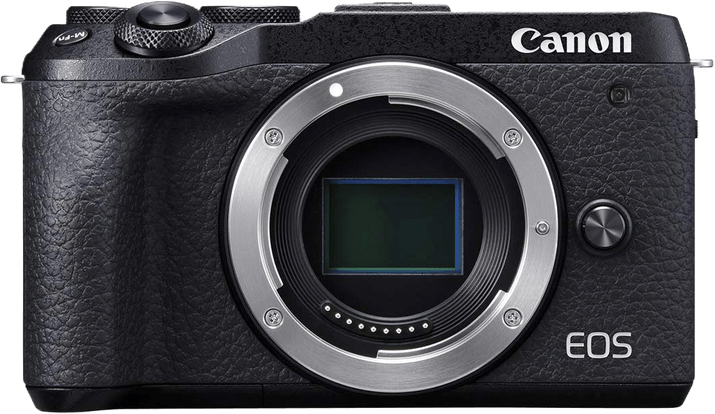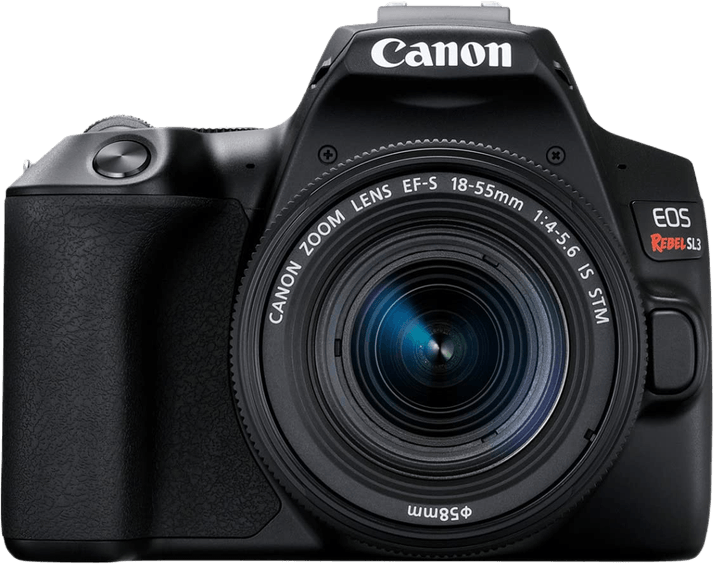Canon EOS M6 Mark II vs EOS Rebel SL3 / 250D Comparison
Canon EOS M6 Mark II

Canon EOS Rebel SL3 / 250D

The Canon EOS M6 Mark II and Canon EOS Rebel SL3 / 250D both score 63/100 in our comparison. These cameras, released in 2019, share some common specifications. They both have the same announcement date and release year, with the M6 Mark II being launched at $850 and the Rebel SL3 / 250D at $599.
The EOS M6 Mark II is a mirrorless camera, which makes it lighter at 408g (0.90lbs) and smaller in size (120 x 70 x 49mm) compared to the Rebel SL3 / 250D, a DSLR camera weighing 449g (0.99lbs) and measuring 122 x 93 x 70mm. This makes the M6 Mark II more portable and easier to carry around.
On the other hand, the Rebel SL3 / 250D has a lower launch price, making it more budget-friendly for those seeking a quality camera without breaking the bank.
Both cameras have their advantages, with the M6 Mark II being more compact and the Rebel SL3 / 250D being more affordable. Ultimately, the choice between the two depends on the user’s preferences and needs.
Canon M6 Mark II vs Rebel SL3 Overview and Optics
The Canon EOS M6 Mark II outperforms the Canon EOS Rebel SL3 in optics, scoring 62/100 compared to 61/100. Both cameras have a CMOS sensor, Digic 8 processor, and APS-C sensor size. However, some differences give the M6 Mark II an edge and some advantages to the Rebel SL3 / 250D.
The M6 Mark II has a higher megapixel count at 33, compared to the Rebel SL3 / 250D’s 24. This means the M6 Mark II captures more detail in images, allowing for larger prints and more cropping flexibility. The M6 Mark II also has a significantly faster shooting speed of 14 frames per second, compared to the SL3’s 5 frames per second. This makes the M6 Mark II better suited for capturing fast-moving subjects and action shots.
On the other hand, the Rebel SL3 has a higher DXOMARK sensor score of 64, compared to the M6 Mark II’s 58. This implies better overall image quality and improved low-light performance. Furthermore, the SL3 / 250D features image stabilization, which the M6 Mark II lacks. This helps reduce camera shake and produces sharper images, especially in low-light situations or when using slower shutter speeds. The SL3 / 250D also uses the Canon EF/EF-S lens mount, providing a wider range of lens options than the M6 Mark II’s EF-M mount.
While the Canon EOS M6 Mark II has a slight advantage in optics due to its higher megapixel count and shooting speed, the Rebel SL3 / 250D offers some benefits, such as a better sensor score and image stabilization.
Canon EOS M6 Mark II vs EOS Rebel SL3 Video Performance
The Canon EOS M6 Mark II outperforms the Canon EOS Rebel SL3 in video capabilities, scoring 91/100 compared to the latter’s 83/100. Both cameras share some common specifications, including 4K max video resolution, 3840 x 2160 max video dimensions, and built-in time-lapse functionality. However, the EOS M6 Mark II offers superior performance in specific areas, making it the better choice for video enthusiasts.
One of the main advantages of the EOS M6 Mark II is its higher max video frame rate of 120fps, compared to the Rebel SL3’s 60fps. This allows for smoother, more detailed slow-motion footage, which can be crucial for capturing fast-moving subjects or creating cinematic effects. The higher frame rate also provides more flexibility in post-production, giving users the ability to slow down or speed up footage as needed.
While the Rebel SL3 / 250D may not match the EOS M6 Mark II in terms of frame rate, it still offers solid video capabilities for its price point. With 4K resolution, built-in time-lapse functionality, and a max frame rate of 60fps, it is a suitable option for casual videographers or those on a budget. However, those seeking the best possible video performance should opt for the EOS M6 Mark II.
Considering their respective video scores and specifications, the Canon EOS M6 Mark II stands out as the superior choice for those prioritizing video capabilities. Meanwhile, the Canon EOS Rebel SL3 / 250D remains a viable option for casual users or budget-conscious buyers who still want quality video features.
Canon M6 Mark II vs EOS Rebel SL3 Features and Benefits
The Canon EOS M6 Mark II and the Canon EOS Rebel SL3 / 250D both have a feature score of 70/100, making them equal in this aspect. They share several specifications, including a 3-inch screen size, a screen resolution of 1040000 dots, touchscreen capabilities, flip screens, and the absence of GPS. Both cameras also come with WIFI and Bluetooth connectivity.
Considering their equal feature scores and shared specifications, the choice between the Canon EOS M6 Mark II and the Canon EOS Rebel SL3 depends on individual preferences and priorities. One may prefer the M6 Mark II for its potential performance advantages, while another may lean towards the Rebel SL3 for its ease of use or design.
Canon EOS M6 Mark II vs Rebel SL3 Storage and Battery
The Canon EOS Rebel SL3/250D wins in the storage and battery category with a score of 45/100, while the Canon EOS M6 Mark II scores 35/100. Both cameras have a single memory card slot and accept SD, SDHC, and SDXC cards. However, the M6 Mark II is compatible with faster UHS-II cards, whereas the Rebel SL3 only supports UHS-I cards.
The Rebel SL3 outperforms the M6 Mark II in terms of battery life, offering 1070 shots compared to the M6 Mark II’s 305 shots. Both cameras use the same LP-E17 battery type. The M6 Mark II holds an advantage in offering USB charging, which the Rebel SL3 lacks.
Although the M6 Mark II has faster memory card compatibility, the Rebel SL3’s significantly longer battery life makes it the winner in the storage and battery comparison. The USB charging feature of the M6 Mark II is a useful addition, but it does not outweigh the benefits of the Rebel SL3’s extended battery life.
Canon EOS M6 Mark II vs EOS Rebel SL3 - Our Verdict
Are you still undecided about which camera is right for you? Have a look at these popular comparisons that feature the Canon EOS M6 Mark II or the Canon EOS Rebel SL3 / 250D:
